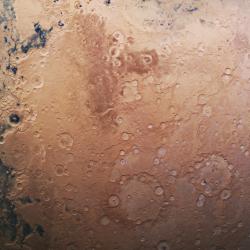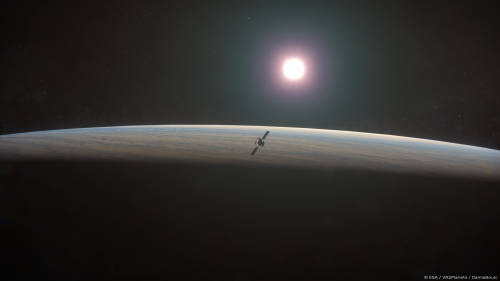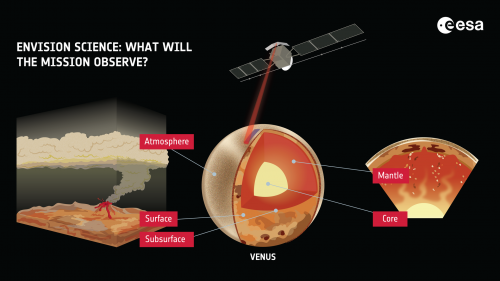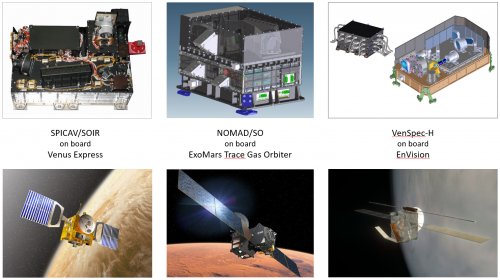ESA’s next mission to Venus was officially ‘adopted’ today by the Agency’s Science Programme Committee. EnVision will study Venus from its inner core to its outer atmosphere, giving important new insight into the planet's history, geological activity and climate. The Royal Belgian Institute for Space Aeronomy will be on board with the VenSpec-H instrument, targeting the measurement of potential atmospheric tracers of volcanism and surface changes on Venus.
Venus is Earth’s closest neighbour – much closer than Mars – and very similar to our home planet in mass and size. Unlike Earth, however, it is not a pleasant place to visit. Of the Solar System’s rocky bodies, it has the densest atmosphere and is completely covered by layers of thick clouds made mostly of sulphuric acid. The surface of Venus is a scorching 464 °C on average, with a crushing air pressure 92 times bigger than we experience on Earth’s surface. This leaves us to wonder: how and when did Earth’s twin become so inhospitable?
Science with EnVision
The measurements EnVision makes will help unravel key mysteries of our hot neighbour. For example, EnVision will reveal how volcanoes, plate tectonics and asteroid impacts have shaped the Venusian surface, and how geologically active the planet is today. The mission will also investigate the planet's insides, collecting data on the structure and thickness of Venus's core, mantle and crust. Lastly, it will study the weather and climate on Venus, including how they are affected by geological activity on the ground.
Special to EnVision is the mission’s approach to studying the entire planet as a system. It will investigate Venus’s surface, interior and atmosphere with unprecedented accuracy, allowing us to understand how they work and interact with each other. For example, EnVision will use multiple measurement techniques to search for signatures of active volcanism at the surface and in the atmosphere.
explains Anne Grete Straume-Lindner, the mission’s project scientist.
To enable this holistic investigation, EnVision will carry an extensive set of scientific instruments. It will be the first mission to directly probe beneath Venus’s surface, using its subsurface radar sounder. A second radar instrument, VenSAR, will map the surface with a resolution down to 10 metres and determine properties such as surface texture. Three different spectrometers will study the make-up of the surface and atmosphere. And a radio science experiment will use radio waves to study the planet’s internal structure and properties of the atmosphere.
Strong instrumental heritage
EnVision will be the second European mission to Venus, after ESA’s Venus Express burned up in Venus's lower atmosphere in 2014 after 9 magnificent years of scientific data gathering. It is also the second time that the Royal Belgian Institute for Space Aeronomy (BIRA-IASB) is on board, as the institute contributed to Venus Express with SPICAV, an imaging spectrometer for ultraviolet and infrared radiation.
SPICAV was derived from the SPICAM instrument flown on Mars Express, which was equipped with two channels, one for ultraviolet wavelengths and one for infrared. SPICAV retained these channels and added an additional one (SOIR, Solar Occultation at Infrared) to observe the Sun through Venus's atmosphere at longer infrared wavelengths.
The SOIR instrument was so successful that two out of three channels of the NOMAD instrument (SO and LNO), currently on board the ExoMars Trace Gas Orbiter, are built upon the expertise. Now, BIRA-IASB continues to build on this important heritage with the development of the VenSpec-H spectrometer.
The Venus Spectrometer with High resolution
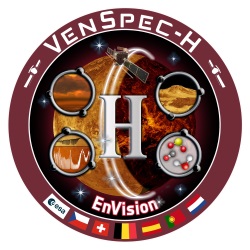
VenSpec-H stands for Venus Spectrometer with High resolution. It is one of three spectrometers in the VenSpec suite, with VenSpec-M (DLR, Germany) and VenSpec-U (CNES, France).
It aims to perform night-side mapping of the near-surface atmosphere and day-side mapping of the atmosphere above the cloud deck. More specifically, VenSpec-H will measure gases, such as water (H2O and HDO), sulfur dioxide (SO2) or carbon sulfide (OCS) using their infrared signatures to monitor their abundances. The targeted atmospheric species are potential tracers of volcanism and surface changes on Venus.
Moreover, these observations will help us understand their effect on cloud maintenance and dynamics and the exchanges between the different regions of the atmosphere.
BIRA-IASB is responsible for the design, manufacturing, testing and delivery of the instrument to the European Space Agency (ESA). Dr. Ir. Ann C. Vandaele is the Instrument Lead Scientist, Dr. Ir. Eddy Neefs its System Engineer and many scientists and engineers at BIRA-IASB are heavily involved in its design.
BIRA-IASB is also managing a quite extended and complex consortium involving many other European countries like Switzerland, Spain, the Czech Republic, The Netherlands, and Portugal, including scientists, engineers and industrial partners, with collaboration and coordination at the level of the VenSpec suite, both on science and engineering level.
The VenSpec suite onboard EnVision, and in particular VenSpec-H, will help better understand how Venus, our closest neighbour, became such a hostile environment with temperatures of more than 450 °C and a pressure more than 90 times higher than on Earth. The instrument will also shed light on the role of some trace gases in the sustained cloud system, mostly composed of sulfuric acid droplets.
says Séverine Robert, the Instrument Scientist. And Eddy Neefs adds:
BIRA-IASB has been involved in the previous ESA mission to Venus (Venus Express) with the SOIR instrument. The selection of the VenSpec-H instrument is the confirmation and recognition of our expertise in this field of exploration
Read more:
ESA press release "We're heading for Venus: ESA approves EnVision"

